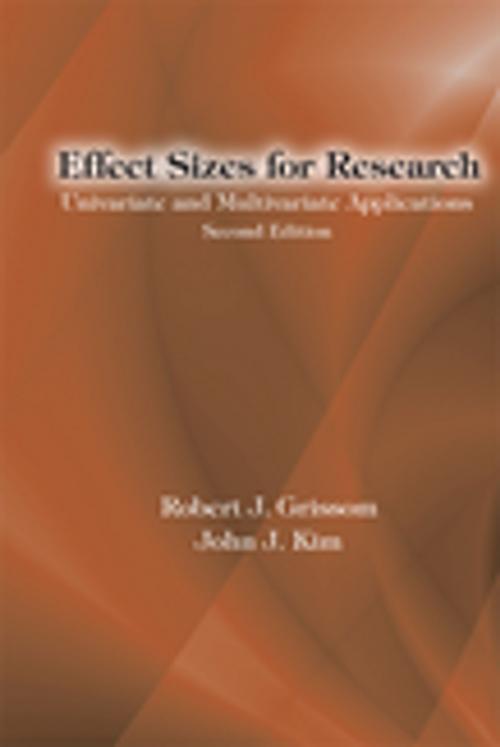Effect Sizes for Research
Univariate and Multivariate Applications, Second Edition
Nonfiction, Reference & Language, Education & Teaching, Teaching, Statistics, Health & Well Being, Psychology, Social & Cultural Studies, Social Science| Author: | Robert J. Grissom, John J. Kim | ISBN: | 9781136632341 |
| Publisher: | Taylor and Francis | Publication: | April 23, 2012 |
| Imprint: | Routledge | Language: | English |
| Author: | Robert J. Grissom, John J. Kim |
| ISBN: | 9781136632341 |
| Publisher: | Taylor and Francis |
| Publication: | April 23, 2012 |
| Imprint: | Routledge |
| Language: | English |
Noted for its comprehensive coverage, this greatly expanded new edition now covers the use of univariate and multivariate effect sizes. Many measures and estimators are reviewed along with their application, interpretation, and limitations. Noted for its practical approach, the book features numerous examples using real data for a variety of variables and designs, to help readers apply the material to their own data. Tips on the use of SPSS, SAS, R, and S-Plus are provided. The book's broad disciplinary appeal results from its inclusion of a variety of examples from psychology, medicine, education, and other social sciences. Special attention is paid to confidence intervals, the statistical assumptions of the methods, and robust estimators of effect sizes. The extensive reference section is appreciated by all.
With more than 40% new material, highlights of the new editon include:
- three new multivariate chapters covering effect sizes for analysis of covariance, multiple regression/correlation, and multivariate analysis of variance
- more learning tools in each chapter including introductions, summaries, "Tips and Pitfalls" and more conceptual and computational questions
- more coverage of univariate effect sizes, confidence intervals, and effect sizes for repeated measures to reflect their increased use in research
- more software references for calculating effect sizes and their confidence intervals including SPSS, SAS, R, and S-Plus
- the data used in the book are now provided on the web along with new data and suggested calculations with IBM SPSS syntax for computational practice.
Effect Sizes for Research covers standardized and unstandardized differences between means, correlational measures, strength of association, and parametric and nonparametric measures for between- and within-groups data.
Intended as a resource for professionals, researchers, and advanced students in a variety of fields, this book is also an excellent supplement for advanced statistics courses in psychology, education, the social sciences, business, and medicine. A prerequisite of introductory statistics through factorial analysis of variance and chi-square is recommended.
Noted for its comprehensive coverage, this greatly expanded new edition now covers the use of univariate and multivariate effect sizes. Many measures and estimators are reviewed along with their application, interpretation, and limitations. Noted for its practical approach, the book features numerous examples using real data for a variety of variables and designs, to help readers apply the material to their own data. Tips on the use of SPSS, SAS, R, and S-Plus are provided. The book's broad disciplinary appeal results from its inclusion of a variety of examples from psychology, medicine, education, and other social sciences. Special attention is paid to confidence intervals, the statistical assumptions of the methods, and robust estimators of effect sizes. The extensive reference section is appreciated by all.
With more than 40% new material, highlights of the new editon include:
- three new multivariate chapters covering effect sizes for analysis of covariance, multiple regression/correlation, and multivariate analysis of variance
- more learning tools in each chapter including introductions, summaries, "Tips and Pitfalls" and more conceptual and computational questions
- more coverage of univariate effect sizes, confidence intervals, and effect sizes for repeated measures to reflect their increased use in research
- more software references for calculating effect sizes and their confidence intervals including SPSS, SAS, R, and S-Plus
- the data used in the book are now provided on the web along with new data and suggested calculations with IBM SPSS syntax for computational practice.
Effect Sizes for Research covers standardized and unstandardized differences between means, correlational measures, strength of association, and parametric and nonparametric measures for between- and within-groups data.
Intended as a resource for professionals, researchers, and advanced students in a variety of fields, this book is also an excellent supplement for advanced statistics courses in psychology, education, the social sciences, business, and medicine. A prerequisite of introductory statistics through factorial analysis of variance and chi-square is recommended.















